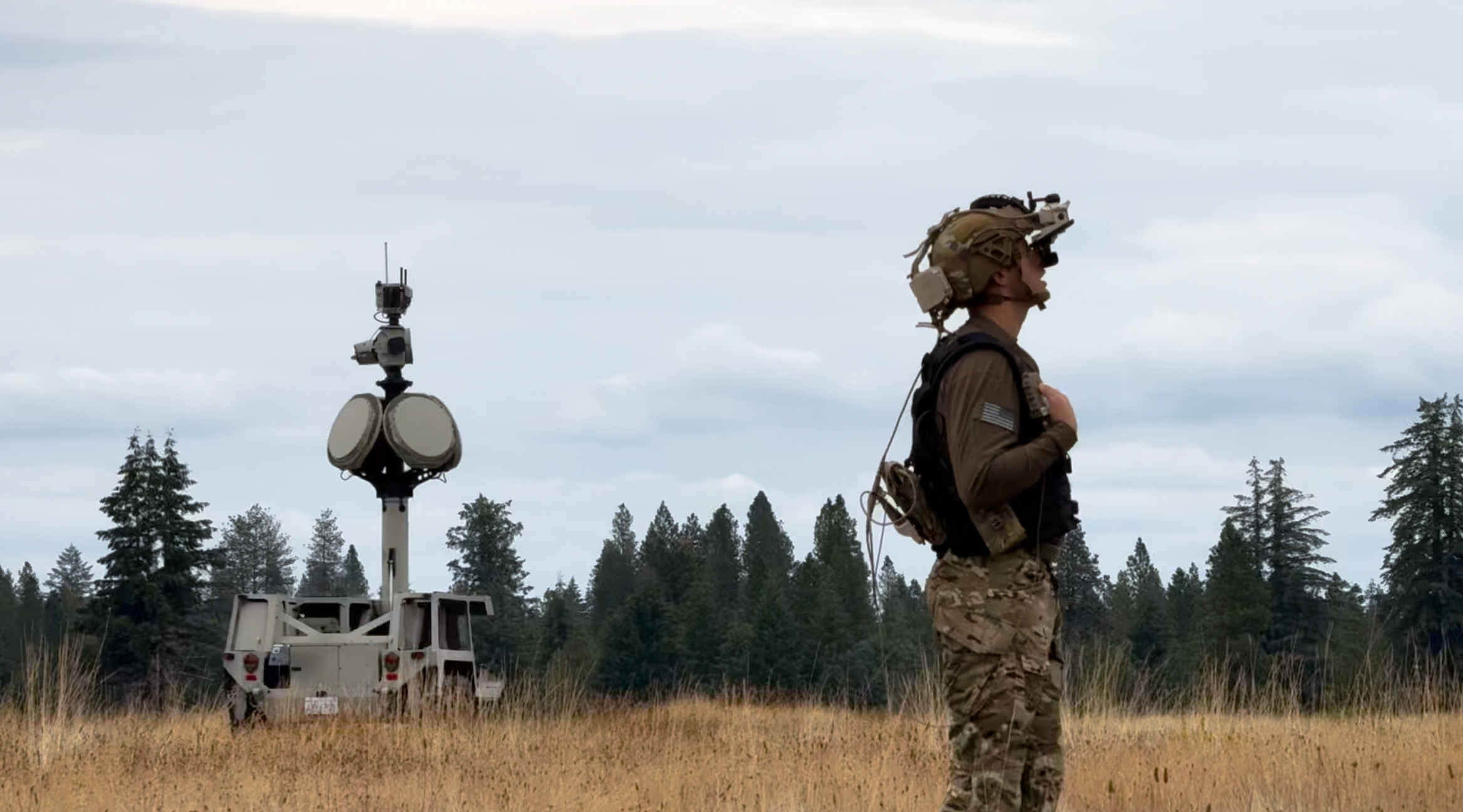A US Army soldier detects small drone threats through Lattice IVAS integration. (Anduril)
WASHINGTON — Oculus founder Palmer Luckey is officially throwing his defense firm Anduril’s hat into the ring to help develop a combat-suitable mixed-reality device for soldiers, announcing a new partnership with Microsoft.
After teasing his tech startup’s broader entrance into the military mixed-reality space, Palmer is now disclosing at least one entry point: the integration of new sensors and the firm’s Lattice platform into the US Army’s latest version of the Integrated Visual Augmentation System (IVAS).
“This project is my top priority at Anduril, and it has been for some time now. It’s one of the Army’s most critical programs being fielded in the near future, with the goal of getting the right data to the right people at the right time,” Luckey said in an announcement today.
Details about the two companies’ current and future IVAS arrangements remain under wraps, but spokespeople from both said Anduril’s Lattice platform has been “successfully integrated” into Microsoft’s hardware and software platform for both the IVAS 1.1 and 1.2 versions. The 1.2 version of IVAS is currently going through testing with the Army, while industry awaits the Army’s official greenlight to kickstart a recompete program under an initiative dubbed IVAS Next.
“This is Anduril’s bread and butter, and we’ve been building the backbone for this for years,” Luckey said.
Lattice is billed as an open software platform that gleans data from different sensors and systems and moves that data into a “single integration layer” where high-value information is filtered for users. For the Army system, the companies say that means that as incoming airborne threats like drones home in on a soldier’s location, they are “autonomously” detected and soldiers donning the upgraded IVAS are warned.
Robin Seiler, Microsoft’s corporate vice president for mixed reality, said the aim is to “expand the impact” the system could have on the battlefield.
“Soldiers using IVAS get instant alerts and can track movements in real-time, without needing to be involved in the detection process. This speeds up the early warning system, which is critical for improving response times and increasing soldier survival,” a Microsoft told Breaking Defense.
IVAS Next
While the collaboration sheds new light on Microsoft’s plans to upgrade its current IVAS offering, a host of questions remain about the path ahead for the tech giant’s mixed-reality program and just which alliances are forming to compete anew if the Army greenlights a new competition.
In 2018, the Army first selected the Washington-based tech company for its coved IVAS program and tasked the team with militarizing the commercially available HoloLens 2. By 2021, the service awarded Microsoft with a production deal valued up to $22 billion with plans to begin fielding the device that same year. But behind the scenes, soldier testing suggested it was a technology not suitable for combat, leading Army leaders to pause development and reset the program.
After several false starts, the Army rolled out an iterative development plan based around three different versions — 1.0, 1.1 and 1.2. That 1.2 version was billed as the big leap ahead and one that could potentially push past tech and user complaints that had ranged from software glitches to physical side effects like dizziness and nausea.
Microsoft overhauled the 1.2 form factor by ditching the helmet-like display that soldiers were not able to easily take off and replaced it with a display that could be flipped up. The field of view was also shrunk from 70-degree down to around 60-degrees to provide more clarity and better alignment with a user’s eyes.
Testing with this new version is still ongoing and could last through an operational assessment slated for early next year. And while the design improvements are headed in the right direction, reports started trickling up the chain that at least some of the testing “wasn’t going the way we wanted it to,” a service official recently told Breaking Defense.
As a result, Army leaders including Chief of Staff Gen. Randy George have tasked Army Rangers with racking and stacking all of the service’s night vision devices to include IVAS. That analysis is expected back this fall and could help decide how the Army envisions soldiers using IVAS and just which units and individuals should have it. The feedback may also help drive requirements for a new IVAS form factor.
Service officials have been preparing tech companies for an upcoming IVAS Next competition that could replace Microsoft as the prime contractor, and multiple industry sources have told Breaking Defense they are waiting for the service to release a formal solicitation, possibly before the end of the year.
That solicitation is expected to shine a light on the Army’s path ahead for the program and could be a key marker as potential competitors set themselves on the starting block. (For now, most are remaining tightlipped about their exact plans, although both Microsoft and Kopin have said they will compete.)
As for Anduril’s IVAS Next ambitions, the company has not released any details. But during AWE 2024 in June, Luckey teased a new headset underdevelopment saying he is “still very much in the hardware space.”
“I’m actually building a new headset right now,” Anduril’s founder told the audience. “It’s driven … by military requirements, but it’s also going to be used for non-military stuff.”
What Luckey did not disclose is whether this was a personal project he was tinkering with, a more formal internal development initiative, or even if it is being built with combat in mind.











